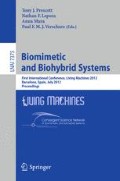Abstract
The honeybee dance communication system is one of the most intriguing examples of information transfer in the animal kingdom. After returning from a valuable food source honeybee foragers move vigorously, in a highly stereotypical pattern, on the comb surface conveying polar coordinates of the field site to a human observer. After 60 years of intense research it remains still unknown how the bees decode the dance. To resolve this question we have built a robotic honeybee that is able to reproduce all stimuli found to be generated in the dance ([12]). By imitating single stimuli or combinations and tracking the bees’ ensuing behavior we are able to identify essential signals in the communication process. In this paper we describe the design of our current prototype, show how we validated the function of the robotic wing buzzes and propose a reactive behavior control on the basis of relative body configurations of nearby bees measured by custom smart camera modules. We will conclude by showing first promising result of field experiments within a live honeybee colony.
Access this chapter
Tax calculation will be finalised at checkout
Purchases are for personal use only
Preview
Unable to display preview. Download preview PDF.
References
Bozic, J., Valentincic, T.: Attendants and followers of honeybee waggle dances. J. Apic. Res. (1991)
De Marco, R., Menzel, R.: Learning and memory in communication and navigation in insects. Learning and Memory-A Comprehensive Reference 1 (2008)
Esch, H., Esch, I., Kerr, W.E.: Sound: An Element Common to Communication of Stingless Bees and to Dances of the Honey Bee. Science 149(3681), 320–321 (1965)
Faria, J.J., Dyer, J.R.G., Clément, R.O., Couzin, I.D., Holt, N., Ward, A.J.W., Waters, D., Krause, J.: A novel method for investigating the collective behaviour of fish: introducing Robofish. Behavioral Ecology and Sociobiology, 1–8 (2010)
von Frisch, K.: Die Tänze der Bienen, Österr. Zool. Z 1, 1–48 (1946)
von Frisch, K.: Tanzsprache und Orientierung der Bienen. Springer, Berlin (1965)
Gil, M., De Marco, R.J.: Decoding information in the honeybee dance: revisiting the tactile hypothesis. Animal Behaviour 80(5), 887–894 (2010)
Griffin, D.R.: Animal minds. University of Chicago Press (1994)
Halloy, J., Sempo, G., Caprari, G., Rivault, C., Asadpour, M., Tache, F., Said, I., Durier, V., Canonge, S., Ame, J.M., Detrain, C., Correll, N., Martinoli, A., Mondada, F., Siegwart, R., Deneubourg, J.L.: Social Integration of Robots into Groups of Cockroaches to Control Self-Organized Choices. Science 318(5853), 1155–1158 (2007)
Kirchner, W.H., Towne, W.F.: The sensory basis of the honeybee’s dance language. Sci. Am. (1994)
Landgraf, T., Rojas, R., Nguyen, H., Kriegel, F., Stettin, K.: Analysis of the waggle dance motion of honeybees for the design of a biomimetic honeybee robot. PloS One 6(8), e21354 (2011)
Landgraf, T., Kriegel, F., Nguyen, H., Rojas, R.: Extraction of motion parameters of waggle dancing honeybees for the design of a biomimetic honeybee robot (in prep.)
Menzel, R., Greggers, U., Smith, A., Berger, S., Brandt, R., Brunke, S., Bundrock, G., Hulse, S., Plumpe, T., Schaupp, F., Schuttler, E., Stach, S., Stindt, J., Stollhoff, N., Watzl, S.: Honey bees navigate according to a map-like spatial memory. Proceedings of the National Academy of Sciences 102(8), 3040–3045 (2005)
Menzel, R., Kirbach, A., Haass, W.-D., Fischer, B., Fuchs, J., Koblofsky, M., Lehmann, K., Reiter, L., Meyer, H., Nguyen, H., Jones, S., Norton, P., Greggers, U.: A common frame of reference for learned and communicated vectors in honeybee navigation. Curr. Biol. 21(8), 645–650 (2011)
Michelsen, A.: Signals and flexibility in the dance communication of honeybees. Journal of Comparative Physiology A: Neuroethology, Sensory, Neural, and Behavioral Physiology 189(3), 165–174 (2003)
Michelsen, A., Andersen, B.B., Storm, J., Kirchner, W.H., Lindauer, M.: How honeybees perceive communication dances, studied by means of a mechanical model. Behavioral Ecology and Sociobiology 30(3), 143–150 (1992)
Rohrseitz, K., Tautz, J.: Honey bee dance communication: waggle run direction coded in antennal contacts? Journal of Comparative Physiology A: Neuroethology, Sensory, Neural, and Behavioral Physiology 184(4), 463–470 (1999)
Seeley, T.D.: The Wisdom of the Hive: The Social Physiology of Honey Bee Colonies. Harvard University Press, London (1995)
Stabentheiner, A., Hagmller, K.: Sweet food means hot dancing in honeybees. Naturwissenschaften 78(10), 471–473 (1991)
Tautz, J.: Honeybee waggle dance: recruitment success depends on the dance floor. Journal of Experimental Biology 199(6), 1375–1381 (1996)
Thom, C., Gilley, D.C., Hooper, J., Esch, H.E.: The scent of the waggle dance. PLoS Biology 5(9), e228 (2007)
Towne, W.F., Kirchner, W.H.: Hearing in honey bees: detection of air-particle oscillations. Science 244(4905), 686 (1989)
Warnke, U.: Effects of electric charges on honeybees. Bee World 57(2), 50–56 (1976)
Author information
Authors and Affiliations
Editor information
Editors and Affiliations
Rights and permissions
Copyright information
© 2012 Springer-Verlag Berlin Heidelberg
About this paper
Cite this paper
Landgraf, T., Oertel, M., Kirbach, A., Menzel, R., Rojas, R. (2012). Imitation of the Honeybee Dance Communication System by Means of a Biomimetic Robot. In: Prescott, T.J., Lepora, N.F., Mura, A., Verschure, P.F.M.J. (eds) Biomimetic and Biohybrid Systems. Living Machines 2012. Lecture Notes in Computer Science(), vol 7375. Springer, Berlin, Heidelberg. https://doi.org/10.1007/978-3-642-31525-1_12
Download citation
DOI: https://doi.org/10.1007/978-3-642-31525-1_12
Publisher Name: Springer, Berlin, Heidelberg
Print ISBN: 978-3-642-31524-4
Online ISBN: 978-3-642-31525-1
eBook Packages: Computer ScienceComputer Science (R0)

